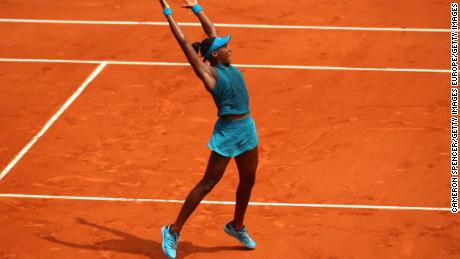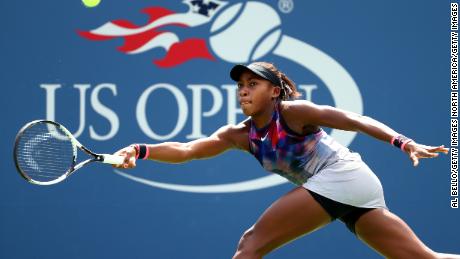Story highlights
- Gauff is the top-ranked junior and reigning junior French Open champion
- At 14, she is allowed to play only eight pro tournaments
- Age eligibility rule criticized by Gauff's coach, Patrick Mouratoglou
(CNN)Just 14, Cori Gauff has the tennis world at her feet.
Having burst onto the scene a year ago at the US Open, where she reached the girls' final at the age of 13, Gauff won her first junior grand slam title at Roland-Garros in June and became the youngest ever junior world No. 1 after Wimbledon.
Nicknamed "Coco," Gauff's achievements have earned the American, who has played just two senior events and has a WTA ranking of 926th, a wild card into this week's US Open qualifying draw.
Except Gauff, widely considered to be one of the most talented players of her generation, will have to wait at least four more years before she will be able to realize her full potential.
That's because of the sport's "age eligibility rule," which forms part of the player development program on the women's WTA Tour. Implemented in 1995, it limits the number of tournaments teenagers can play, to prevent early age burn-out.
It's a rule that has drawn criticism, notably from Serena Williams' coach Patrick Mouratoglou, who has been guiding Gauff since he first spotted her at the age of 11.
"This is completely unfair to players who are able to achieve something at that time of their life and career," Mouratoglou told CNN Sport. "This is against diversity; I think tennis is interesting because it's diverse."
'High-stakes environment'
Gauff, who was beaten by Briton Heather Watson 6-4 6-1 in that US Open qualifier, might be an outlier for her age -- "Coco is a wonderful talent," Ashley Keber, WTA vice president, member relations, told CNN Sport -- but the organization that runs the women's game says the eligibility rule is vital, however talented any teenage player might be.
"I think at the very core of the rule is that these are children competing in an adult work place, full stop," said Keber, who adds that the women's Tour is "a high-performance, high-stakes environment, so you really need to be at your peak."
Although some players can look physically strong at 14, "their development is not linear," as they go through the various stages of adolescence, according to Keber.
"Their physical development might be more progressed than their emotional, or their cognitive. Or they may be more emotionally developed and their physical still needs time to catch up.
"It can happen in spurts and stops, but it's not all happening at the same rate. And that's important to take into account."
Capriati's struggle
The age rule was brought in following a number of cases of burn-out of high-profile players, most notably Jennifer Capriati, an American teen prodigy who turned pro at 13, reached the top 10 at 14 and became an Olympic champion at 16 at the 1992 Barcelona Games.
A global star and millionaire at 13, Capriati struggled with her sudden rise to fame and fortune, and by the time she was 18, her career had been derailed by off-court problems including arrests for shoplifting and marijuana possession charges.
Although she staged a successful comeback in her mid-20s, clinching three majors in 2001 and 2002, her meteoric rise wouldn't be possible today.
These days players aged 13 or younger can't play any events on the WTA Tour, the ITF women's circuit, the Fed Cup team event or the Olympics.
At 14, girls are allowed to play up to eight pro events a year, in addition to a maximum of 18 junior tournaments, an allocation which gradually increases with each birthday until the player turns 18, when they are free to play in as many events as they want.
This means Gauff, who has played two senior events since her 14th birthday, has six more left to enter before she turns 15.
Short-term pain, long-term gain
"She's amazing because she's an incredible fighter and she is an incredible athlete," Mouratoglou has said of Gauff's sporting prowess. "She goes for her shots and takes the risks."
However, as well as arguably not being able to fulfill her tennis talent, by not being able to play a full schedule until she is 18, Gauff may be losing out on millions of dollars in prize money and endorsements.
At next week's US Open, the season's final tennis major, a record prize money pot of $53 million is up for grabs, including $3.8 million each for the men's and women's singles champions. The world No. 100 on the women's Tour is a 19-year-old Russian called Anna Blinkova, who has earned more than $500,000 in her career, including just over $260,000 so far this season.
Gauff is one of the few junior players who has her own agent, Alessandro Barel Di Sant Albano, who works for Team 8, the agency formed by 20-time major winner Roger Federer and his long-time agent, Tony Godsick.
During Wimbledon, Barel Di Sant Albano said he had already received quite a few endorsement offers for Gauff, but turned them down to give her time to focus on her tennis first.
Although Gauff may be losing out financially in the short term, she may very well end up earning more in the long-term because it's likely her career will last much longer compared to teenagers who played before the age rule came in.
Since the rule was introduced, WTA Tour careers are lasting, on average, two years longer, while burn-out rates (players who retire before the age of 22), have dropped from over 7% to less than 2%, according to Keber.
"So we are keeping our top players in the game, which is really important, we are giving them that opportunity to have a long career," she said.
Mouratoglou criticism
Although careers are lasting much longer -- Williams is the 6-1 favorite alongside the top-ranked Simona Halep to win the US Open at the age of 36 -- teenage grand slam champions are now a rare sight.
Russians Svetlana Kuznetsova, who won the 2004 US Open at the age of 19, and Maria Sharapova, who took the Wimbledon title that same year at 17, are the last teenagers to win a women's singles grand slam title.
Nonetheless Mouratoglou, the founder and president of the Mouratoglou Tennis Academy in France where Gauff trains, remains unconvinced about the rule.
""It doesn't make any sense, because tennis is about momentum, and if you break the momentum of the players, then maybe Martina Hingis would never have been No. 1 in the world," he said, referring to the Swiss star, who won all of her five grand slam singles titles between the ages of 16 and 18 in the late 1990s. She didn't play under the age rule.
'Teenage phenoms'
Keber said the age rule gets reviewed each year by a panel of experts and that there have been some changes to reflect so-called "teenage phenoms" such as Gauff.
For example, exceptional players aged between 15 and 17 are allowed to play four extra tournaments on the back of strong performances, such as being ranked high enough to gain direct entry into the main draw of a grand slam event.
"By the time a player is 16, if she really talented, I would expect someone like a Coco Gauff, by the time she is 16, she can play 16 events a year, plus Fed Cup, plus Olympics, plus exhibitions," said Keber. "And that's totally on the pro level."
"By the time she is 17, she can play more than a full-ranking schedule, she can play 20 events. This is projecting forward, because the rule can change, year to year. It could be different."
Gauff's father
Gauff's father, Corey, played basketball at Georgia State University while her mother, Candi, excelled in gymnastics before becoming a track star at Florida State University.
Gauff's father was critical of the rule during last year's US Open.
"They put this thing in place for something in the past that didn't go well," he told the New York Times. "That's what the rule is for, and I don't think that is this situation. I just want to give her the chance to compete with better players."
Keber stressed the importance of phasing in young adults into a highly competitive and stressful environment, particularly at an age where parents and coaches often still play a key role in their careers and decision-making.
"There certainly were issues with young players that were 13 or 14, their burn-out rate was fairly high back in the day," she said.
"When you are going through adolescence, there are critical stages and stages for your emotional, for your cognitive and for your physical development," said Keber.
"We do know that 14 and 15-year-olds are the most vulnerable, and that's where you will see more strict regulation."
"The WTA feel strongly that the health and well-being of all of its athletes is our No. 1 priority," she said. "And I think you see that reflected in what we offer to all of our athletes, and in particular the attention to young athletes.
"We welcome them into the game, we love having them be part of the game, it's the history of tennis, and our goal is, we want them to be a part of the game for an extended period of time."































